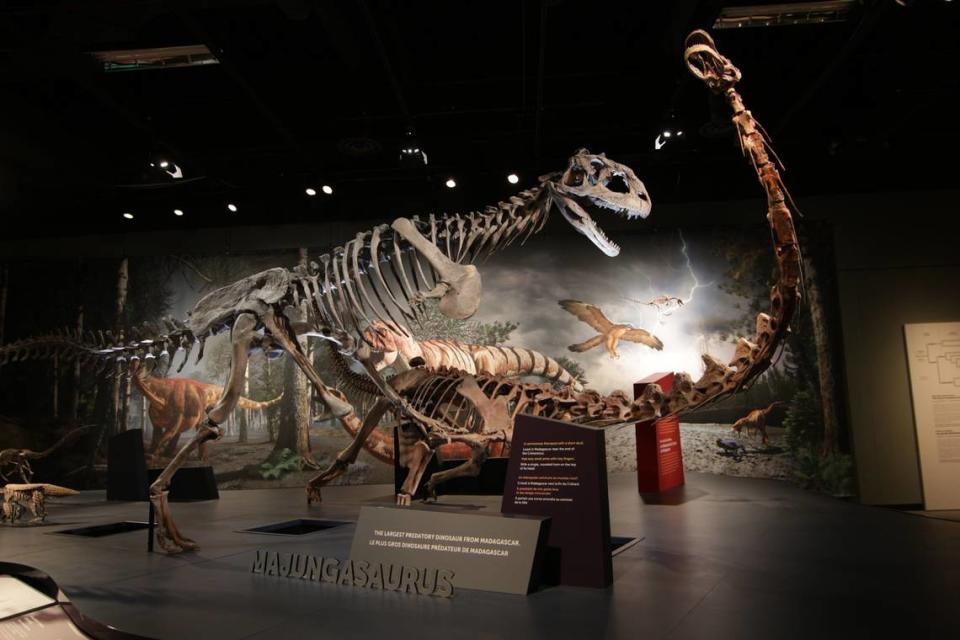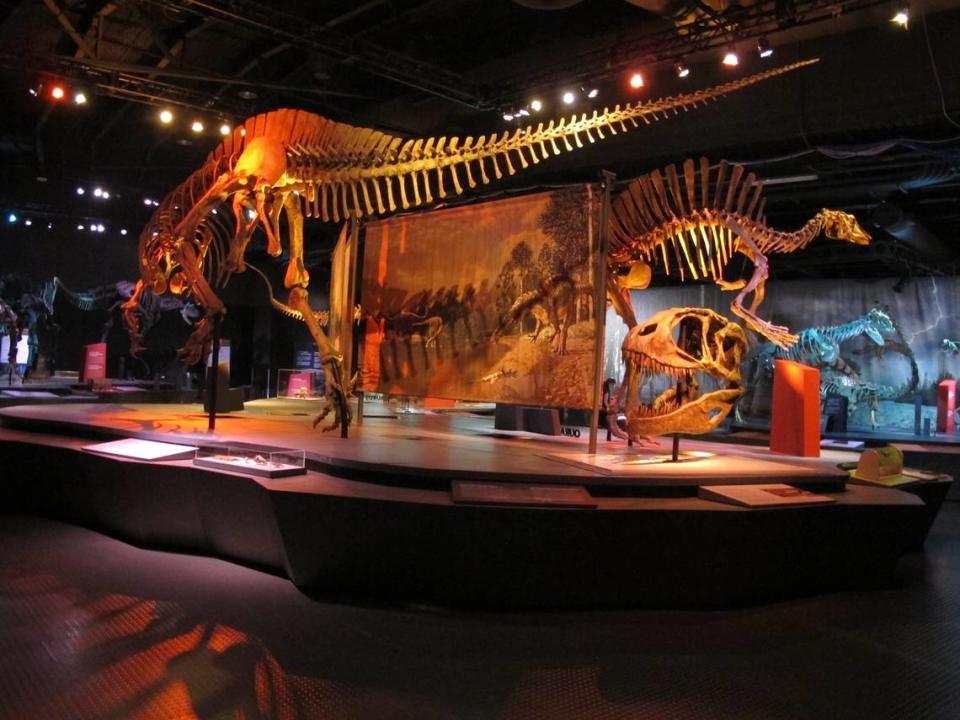Meet the unusual dinosaurs at the new Discovery Place exhibit. Some assembly required
If you’re looking for something cool (and someplace cool!) to visit in the Charlotte area this summer, Discovery Place Science may have just the thing to spark the imaginations of kids of all ages.
A new exhibit, “Ultimate Dinosaurs,” will be here for a limited time, from June 21-Sept. 8. Exhibit access is included with the cost of admission to the uptown Charlotte museum.
The show will feature 16 rarely seen and complete dinosaur specimens from the Southern Hemisphere. These dinosaurs, which once roamed South America, Africa and Madagascar, are different than their better-known Northern Hemisphere cousins.
Their unusual adaptations, which are explored in the exhibit, are thanks to the breakup of the supercontinent Pangea, which caused land masses to drift into isolation during the Mesozoic Era, starting 250 million years ago and continuing through about 65 million years ago.
The exhibit, presented by the Science Museum of Minnesota and created/produced by The Royal Ontario Museum, Toronto, is the first dino show to visit Discovery Place in four years. That last show, “Antarctic Dinosaurs” in 2020, was cut short by the pandemic.
Besides the unusual dinosaurs on display, “Ultimate Dinosaurs” has some cool tech features that make it stand out from other exhibits you may have seen in the past. It incorporates augmented reality so visitors can better visualize how these dinosaurs looked and moved in their habitats.
The Charlotte Observer checked in with Heather Norton, Discovery Place’s Chief Science Officer, to find out some more fun facts about the exhibit. Here are 8 things to know before you go:

Many of these dinosaurs are recent discoveries
As little as 40 years ago, many of these dinosaurs were unknown to scientists.
Fossils from the 33-foot long Suchomimus (pronounced SOO-ko-MY-muss), for example, were first uncovered in the Sahara Desert of Niger in 1997.
Another dinosaur species, Rapetosaurus (pronounced rah-PAY-too-SORE-us), was first found in Madagascar in 1993. A group of scientists discovered it when exploring an area where French military men had reported spotting various fossils nearly a century earlier.
Differences between Southern, Northern Hemisphere dinosaurs
“The separating continents of the Cretaceous period created two very different worlds, and this exhibition tells the story of the break-up of supercontinent Pangea, which divided first into Laurasia in the north, and Gondwana in the south,” Norton told The Observer in a statement.
She said research which only began about 40 years ago shows that Gondwana was home to very different species, which evolved independently, from those found in Laurasia.
“Across the north, duck-billed hadrosaurs and horned ceratopsians roamed Laurasia’s redwood
forests. To the south, gigantic, long-necked sauropods and a unique array of two-legged predators flourished on the continents emerging from Gondwana.”
One dino on exhibit is named after a famous rockstar
One carnivorous dinosaur with sharp teeth sticking straight out from its bottom jaw was given the name Masiakasaurus knopfleri, which means “Knopfler’s vicious lizard.”
That’s in tribute to Mark Knopfler, lead guitarist and singer for Dire Straits, whose music the expedition leaders were reportedly listening to at the time of the find.

From the tiny to the gigantic
Dinosaurs came in a range of sizes. One of the world’s earliest dinosaurs, Eoraptor (pronounced EE-oh-rap-ter) from Argentina, was not much bigger than a medium-sized dog, weighing about 50 pounds and measuring three feet long.
Another dinosaur on display rivals the Northern Hemisphere’s better known Tyrannosaurus Rex in size. Giganotosaurus (pronounced gig-an-OH-toe-SORE-us) was the largest carnivorous dinosaur in Gondwana and may have been the largest land predator ever. Experts think it measured up to 43 feet long and 23 feet high.

Are these real dinosaur bones on display?
The dinosaurs featured in the exhibit are made from casts of real dinosaur bones.
“The process involves making a mold of a fossil to preserve its shape and surface details and then filling in the mold with either latex or resin to create the replica fossils (or bones),” Norton said.
The dinosaur skeletons used to make casts for this exhibit are mounted in museums in Argentina, Zimbabwe, Niger and Malawi, as well as the Field Museum in Chicago and the American Museum of Natural History in New York City, she said.
Replica copies that travel enable people from around the world to experience and learn from them.
But in addition to the fully articulated casts, there are also some original fossils on display as part of the exhibit. They include teeth from several species of dinosaurs, leg bones, and even crocodilian osteoderm (bony deposits in skin).
These fossils are on loan from the Royal Ontario Museum in Toronto.

Just like IKEA furniture, skeleton casts arrive partially assembled
Norton said that when the casts arrive, they are essentially “giant puzzle pieces put together by our incredibly talented exhibits team. Instead of each bone being shipped individually, many pieces (like the legs) ship as an assembled unit that fit together to ‘make’ a dinosaur.”
These components are shipped in large crates into which they have been carefully placed, strapped in and labeled with the appropriate dinosaur name.
AR and other hands-on activities as part of the exhibit
Tablets will be available throughout the exhibit for guests to scan the skeletal casts. “The technology layers virtual experiences over the skeletal casts, creating 3-dimensional, life-like visuals to enhance users’ experience of these amazing southern hemisphere dinosaurs,” Norton said.
In addition, there will be hands-on activities for visitors to explore.
These include a microfossil sifter where visitors can sift through sand and learn how archaeologists search for fossils and tactile activities where visitors can touch and compare bronze casts of specimens,.
There’s also a scaled diorama section for young children to play and learn about the dinosaurs. And there’s a game where visitors piece back together Gondwana while exploring the concepts of evolution, tectonic plates and continental drift.
Who says dinosaurs are just for kids?
The museum, of course, welcomes visitors of all ages. It also offers special adults-only, after-hour opportunities to visit the exhibit through its monthly Science on the Rocks events. These 21+ events will feature music, a bar, live science shows and hands-on dinosaur-themed lab activities, catered to adults.
The next Science on the Rocks event happens on June 21.

Want to go?
“Ultimate Dinosaurs” is open now through Sept. 8 at Discovery Place Science, 168 W 6th St., Charlotte
Hours: 9 a.m.-4 p.m. weekdays, and 10:30 a.m.-4:30 p.m., Saturday and Sunday
Tickets: Adults: $23-$29; Children: $18-$24 ; (Kids under age 2 are free); Seniors: $20-$26.
More arts coverage
Want to see more stories like this? Sign up here for our free “Inside Charlotte Arts” newsletter: charlotteobserver.com/newsletters. And you can join our Facebook group, “Inside Charlotte Arts,” by going here: facebook.com/groups/insidecharlottearts.


